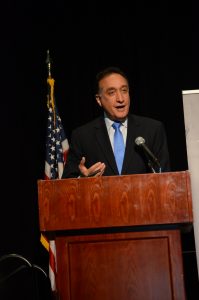A robust mix of housing types and prices is critical to continued economic and social development in Palm Beach County, but current trends are pricing many average buyers and renters out of the market, forcing them to live far from their jobs or convincing them to move to other cities.
That was one of the main messages delivered Wednesday to about 500 developers, housing experts, bankers, community leaders and government officials attending the Palm Beach County Housing Summit in West Palm Beach.
Experts, led by Henry Cisneros, the former mayor of San Antonio, Texas, who served as Secretary of Housing and Urban Development under former President Bill Clinton, said that efforts over the past decade to increase affordable and worker-oriented housing in the county have produced very limited results, and warned that public, private and non-profit groups must begin now to implement a consistent, long-term effort to build more affordable and worker housing, or face negative consequences.

Henry Cisneros (Credit: Palm Beach County)
Excessive regulatory costs were cited by Cisneros and other speakers as putting the brakes on new affordable and worker housing.
While Palm Beach County is already “a classic high opportunity, high-growth area,” much of the focus is on “creating jobs, not affordable housing,” said Cisneros, who now is chairman of CityView companies, which builds homes for average families in 13 states, and chairman of the executive committee at Siebert, Cisneros, Shank & Co., a Wall Street underwriting and municipal finance firm.
Palm Beach County’s current population is about 1.4 million, he said, and it added 22,000 people between 2015 and 2016.
Cisneros drew a big laugh from the crowd by telling them that, over the years, he has heard his name pronounced “Mayor Sclerosis” and “Mr. Cheesenachos,” and that he was pleased to hear it pronounced correctly in Palm Beach County.
Like other large urban areas, the county faces issues like urban gentrification. “Only people with money can afford to rent or own,” he said. Meanwhile, per capita and household incomes that have not kept up with increases in housing costs and “unfavorable skewing in economic and racial terms.” Also, some established communities don’t want to see new, denser developments located near them for worker housing, and heavy local regulations and fees can add about $80,000 to the cost of an average home, Cisneros said.
If urban areas like Palm Beach County want to continue attracting big economic engines and job creators like major hospitals and universities, they need to establish more affordable housing near work centers to improve the quality of life for residents.
“We’re part of a global urban renaissance … and Palm Beach County is at a point of inflection,” said Cisneros. “Its rates of population growth and economic development will determine what its role will be not only in South Florida, but also in the system of U.S. cities. The [current] federal government is not only withdrawing from equity, but also from housing,” where it has traditionally played an important role. “Local governments will have to fill the gap.”
Some solutions? Affordable and workforce housing must be assigned top priority. “It is not a sidebar issue,” he said. And the county needs to put together an effective, structured long-term program for developing affordable housing that brings together public, private and community groups
In addition, echoing suggestions made by other speakers at the summit, Cisneros pointed to solutions like focusing more investments on designing and developing lower-cost housing; turning to smaller units, perhaps prefab or manufactured housing (that meets Florida’s building codes); “lifespan homes” for older people that are general smaller and offer safety amenities like a no-step front door, lower placement of cabinets and internal lighting (like emergency floor lights on airplanes) that guide residents to exits or bathrooms at night.
Palm Beach County’s affordable housing issues are shared by Broward and Miami-Dade counties, participants said.
Speaking before Cisneros, a prominent expert on city planning and economic development from Florida International University gave some startling figures on the status of affordable housing in Palm Beach County, pointing out that even as the population has grown in the county, home ownership (with mortgages) between 2006 and 2015 fell 12.6 percent, from 237,303 to 209,277.
“Workforce housing is critical, and to continue economic expansion, we have to retain workers,” said Edward “Ned” Murray, associate director of the Florida International University Metropolitan Center and a key contributor to several important South Florida planning and economic studies.
In Palm Beach County, median home prices stand at about $327,000, a price level that is not affordable for 75 percent of county residents, or about 400,000 people, Murray said. Median gross rentals cost $1,900 a month, a figure that is out of reach to 80 percent of renters.
About 56 percent of renters (about 100,000 people) are “cost burdened” (paying more than the standard percentage of income that should be spent on housing), while 30 percent (about 53,000) are “severely burdened,” or paying more than 50 percent of income for rent.
Murray estimated that low- and modest-income families in the county spend about 67 percent of their pay on housing and transportation, since they typically have to travel long distances to reach low-paying jobs.
Solutions are not easy. Affordable and accessible housing must be viewed as a key issue in public policy, along with sustainability and quality of life, he said. And the county must develop a long-term commitment that includes public agencies, private companies and non-profits. “Federal and state governments cannot do this,” Murray said. “Solutions have to be developed locally through private-public partnerships.”
Private sector participants also offered examples of how to confront the shortage of affordable dwellings. While some investors view affordable dwellings as a less-than-attractive target, John “Jack” Weir, president of Eastwind Development, told summit participants that workforce housing “is a huge, untapped market, a sector of the free market that’s not working as well as its should.”
Investors see workforce housing “as a product that requires a higher yield, from 18-20 percent,” Weir said, since rents are lower than the rest of the market. Yields should be brought down to the 12-14 percent range.
Local government fees are a “huge part of costs” involved in affordable/worker housing, he said. Also hampering access to this market are high land costs and rising construction costs.
John Csapo, chief development officer at the Kolter Group, primarily a market-rate single-family home builder, talked about a successful project in worker housing. Several years ago, Kolter acquired the 37-acre Wellington Club property near State Road 7 in Lake Worth. The project was originally designed for 76 single-family homes, but after long negotiations with government officials, Csapo said his company was able to obtain permission to increase density and develop 204 rental units, including 154 workforce apartments and 50 market-rate units.
The complex is very well maintained and doesn’t look like some developments with lower cost apartments, he said, a big plus for attracting new renters. For investors, the revenue stream from the apartment mix is attractive, and rents can be increased, though he said increases for worker apartments do not rise as much as the open-market units.
Csapo pointed out that while government agencies generally don’t like to offer credits for impact fees or tax abatements, flexibility in areas like these is important in promoting new affordable housing. “The county wants to attract new companies and jobs,” Csapo said, “but it’s important to attract new affordable housing for these companies.”
A Davie company that specializes in housing for low- to moderate-income families as well as temporary and permanent emergency dwellings offered an affordable solution related to international trade. Shipping companies sell their old containers, which are typically made of steel. Usually they are 20-40 feet long. A 20-foot length container, for example, is 8-feet wide and 8.6 feet high, or 160 square feet.
Craig Vanderlaan, executive director of Crisis Housing Solutions talked about a wide range of completed projects in the U.S. and overseas that use refurbished containers for single-family homes, homes or businesses with one floor or more, mixed-use commercial and residential complexes, and even a multistory building made from containers standing on end that has an elevator.
“They’re like Lego blocks,” Vanderlaan said. The containers are relatively cheap and can be used individually or combined into imaginative complexes. “A multi-family structure with 50 units can be built with 15 percent savings.”
A creative commercial structure, The Hive FTL, is being developed in Fort Lauderdale using containers.
